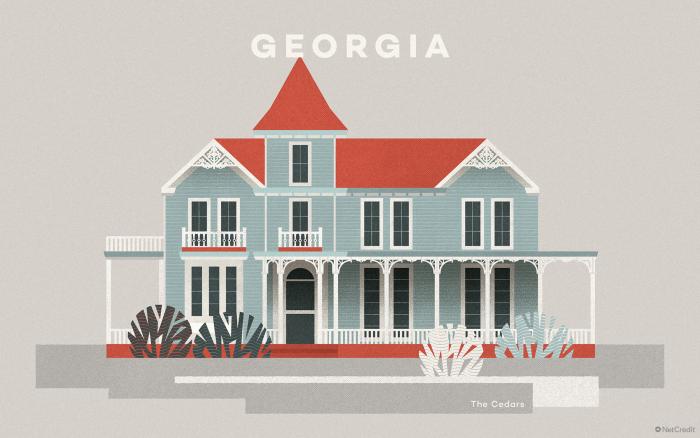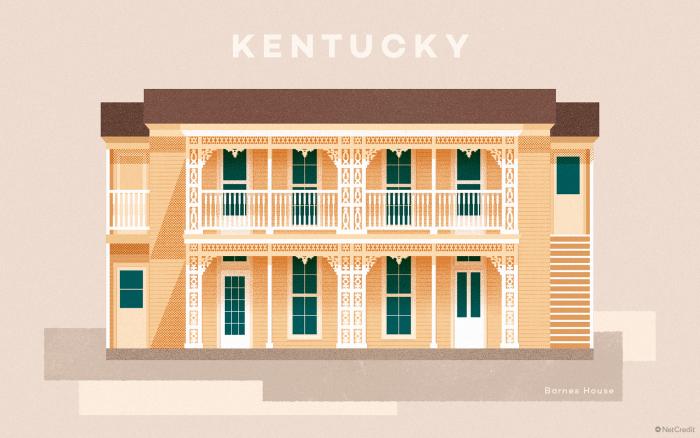Two companies, NetCredit and NeoMam Studios have teamed up to present an illustrated guide to America’s most vulnerable buildings that could disappear forever.
They researched all 50 states to create the list which includes glass domes and swimming pools, Masonic lodges, schools, even laundrettes that are well-loved but face disintegration or demolition. A large number of houses are included in the list, former homes that show buildings aren’t just structures with economic value, but spaces and designs through which we live our lives.
Here’s a selection of the houses, of a wide variety of architectural styles, that are in the danger zone:
Arkansas

Arkansas
The Scipio A. Jones House at Little Rock in Pulaski County was the 1928 home of the prominent African American attorney and civic leader. The home is unsecured and is in poor condition. Currently for sale, it is eligible for historic tax credits.
Connecticut

Connecticut
The former houses of Mary and Eliza Freeman have been vacant since the early 1980s and are in dire need of stabilisation and repair. The sisters lived as free African Americans from birth as, despite the fact that slavery wasn’t officially abolished in the state until 1848, their parents owned property in Derby which allowed their children to grow up somewhat removed from the practice other African Americans suffered at the time.
Delaware

Delaware
The Jester Farmhouse was built in the early 1800s and was owned by the Day family from around the time of the time of the Civil War until World War II. Talks are ongoing between the county and an arts group with the intention of upgrading the space into an arts centre.
Georgia

Georgia
The 18-room Cedars house is an excellent example of Victorian architecture, built on land first owned by George Walton, one of the signatories of the Declaration of Independence. The building has fallen into disrepair with no improvements since the early 2000s. It is in significant danger of demolition by neglect.
Kentucky

Kentucky
The Henry J. Barnes House in Mt. Washington, Kentucky, was built in 1885. It was listed on the National Register of Historic Places in 1993 and runs the risk of becoming another big box store (CVS). The area has lost nine of 12 National Register properties since 1993, leaving very little of historic character, and significant loss of heritage and cultural tourism.
Maryland

Maryland
One of Maryland’s most unique historic homes, the Beatty-Cramer was built around 1732 and is a blend of Dutch and English architecture. It is owned by the Frederick County Landmarks Foundation and needs a new use and purpose, supported by Preservation Maryland.
Minnesota

Minnesota
The Oakland apartments in Minneapolis were constructed in 1889 but suffered a major fire in 2016. Owners say the property is beyond repair and its demolition has been recommended by city code inspectors. But the Heritage Preservation Commission has pushed for the building to be salvaged and voted down the demolition permit. Its future is still in doubt as back-and-forth over demolition continues.
Mississippi

Mississippi
The Lundy Old Stagecoach Inn is the oldest existing property in Lexington at more than 150 years old. It is scheduled for demolition.
Nebraska

Nebraska
The Chauncey S. Taylor House in David City was put on the National Register of Historic Places in 1982. It was listed as a nuisance by the city in 2009 and it was later condemned by building inspector Raymond Sueper. The house has been primarily used for storage and, while structurally sound, porches have been left to rot, plants are overgrown, paint is peeling and the home is very cluttered.
New Hampshire

New Hampshire
Eagle Pond Farm, the former home of poets Jane Kenyon and Donald Hall, was the inspiration for much of their literary work. The Don and Jane Project seeks to collect items from the poets’ lives and preserve the buildings.
North Dakota

North Dakota
Theodore Roosevelt’s Elkhorn ranch is threatened by a proposed bridge on one side, as well as the potential development of private mineral rights scattered throughout the Elkhorn ranch lands. A gravel mine pit has been proposed for very nearby.
Vermont

Vermont
The Mansion House in Winooski, Vermont is listed on the Vermont State Register of Historic Places. There has been a concerted effort in recent times to halt a planned demolition of the 19th century building.
Virginia

Virginia
The Carr-Greer farmhouse was built around 1880 by emancipative slave Hugh Carr. Conservationists are seeking help with fundraising to fix broken windows, cracks, roof leaks and some foundation issues.
Wyoming

Wyoming
The Cooper House is architecturally significant in the state for its unique combination of two early 20th century period-revival styles: Mission Revival, based on the architecture of Californian missions; and Pueblo Revival, based on Pueblo-Indian building traditions in New Mexico. It has been the home of the American Studies Program at University of Wyoming since the 1980s. UW says it has never considered demolishing the building but is considering as a possible location for a new dorm and/or parking garage.